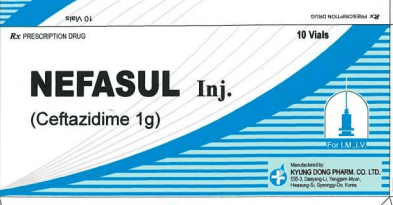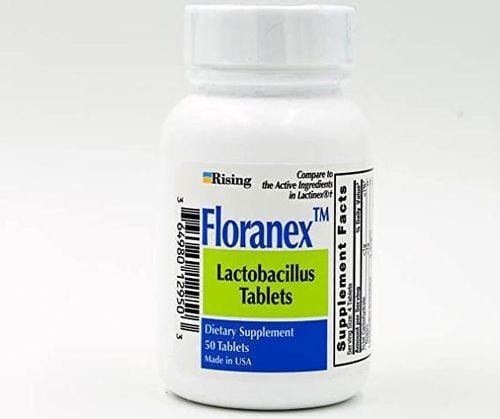This is an automatically translated article.
Fortamox 1g is an antibiotic that supports the treatment of children 12 years of age and older and adults with symptoms of infection caused by susceptible strains of bacteria. Fortamox medicine 1g for fast effect, especially indicated for subjects with severe disease.
1. What is Fortamox 1g?
Fortamox 1g belongs to the group of drugs to prevent infections, inhibit parasites, antivirals and antifungals. Fortamox 1g is directly manufactured by Domesco - Vietnam Medical Import-Export Joint Stock Company, with registration number VD-32714-19.
Fortamox medicine 1g has 2 main ingredients, Amoxicillin 875mg and Sulbactam 125mg, prepared in the form of film-coated tablets. Store Fortamox 1g in a cool, dry, clean place, the temperature is below 30 °C.
The shelf life of Fortamox 1g is 24 months from the date of manufacture. The packaging of the drug is quite diverse with aluminum - aluminum blister material and aluminum - PVC blister material as follows:
Box of 1 blister, 2 blisters, 10 blisters x 7 tablets. Box of 1 blister, 2 blisters, 10 blisters x 10 tablets.
2. What are the effects of Fortamox 1g?
Uses of Fortamox 1g is to support the prevention and treatment of infections caused by sensitive bacteria. Target users are adults and children 12 years of age and older.
Patients with lower respiratory tract infections, otitis media caused by H. influenzae, Moraxella catarrhalis beta-lactamase-producing bacteria. The patient has skin infections and skin tissue infections caused by Staphylococcus aureus, Enterococcus strains, etc. The patient has a urinary tract infection caused by Escherichia coli, Enterococcus bacteria,... caused.
3. Contraindications for taking Fortamox 1g
Do not use Fortamox 1g in subjects who are allergic or sensitive to the drug's ingredients or to Cephalosporin and Penicillin groups of antibiotics. Do not use Fortamox 1g when there is a history of gastrointestinal disease, Crohn's disease, ulcerative colitis, inflammatory bowel disease, ... Do not use Fortamox 1g when there is a history of jaundice, impaired liver function .
4. How to use, dosage of Fortamox 1g
In order to use Fortamox 1g to be most effective, patients need to know how to use it and how much to use.
4.1. How to take Fortamox 1g Take Fortamox 1g with lots of water, before or after eating. Do not take Fortamox medicine 1g with tea, beer or wine or coffee, ... because it reduces the effect of the drug, even causing harm to the body. When taking Fortamox 1g should not chew or crush the drug, ... because it can reduce the effect of the drug. 4.2. Dosage of Fortamox 1g For Fortamox 1g, patients need to use the correct dosage prescribed in the prescription. Absolutely do not arbitrarily increase or decrease the dose of Fortamox 1g.
Usual dose for children from 12 years old (weighing 40kg or more) and adults with severe infections:
Each time taking 1 tablet and taking Fortamox 1g each time, 8 hours apart. For patients with renal failure (adjust dose through creatinine clearance):
Creatinine clearance > 30ml/min: Use usual dose Creatinine clearance from 10-30ml/min: Each time Take 1 tablet and take Fortamox 1g each time, 12 hours apart. Creatinine clearance < 10ml/min: Take 1 tablet each time and take Fortamox 1g each time, 24 hours apart. For patients on hemodialysis:
Take 1 tablet each time and take Fortamox 1g every 24 hours. In addition, 1 additional dose is given during and after the hemodialysis period. Note: For children under 12 years of age and weighing less than 40kg, Fortamox 1g is not suitable for the treatment of disease.
5. Handling of missed dose and overdose of Fortamox 1g
If a patient forgets a dose or uses an overdose of Fortamox 1g, it is necessary to take timely measures.
5.1. If you forget a dose of Fortamox 1g If you forget a dose of Fortamox 1g, take it as soon as you remember. If the missed dose of Fortamox 1g is almost time for the next dose, skip the missed dose and take the next dose. Absolutely do not take a double dose of Fortamox 1g. 5.2. Case of Fortamox 1g overdose Typical symptoms when using Fortamox 1g overdose: Interstitial nephritis, oliguria,...
If overdose, the patient should stop taking the drug, call the doctor for advice on how to handle it. or immediately go to the Resuscitation - Emergency Department, Poison Control Center for timely support.
In the case of a recent overdose of Fortamox 1g, the doctor may induce vomiting and gastric lavage. Alternatively, your doctor may perform hemodialysis.
6. Side effects of Fortamox 1g
In addition to the above uses of Fortamox 1g, many patients when using the drug will experience some unwanted side effects such as:
Common side effects: Nausea and vomiting, diarrhea, indigestion, epigastric pain. Rare side effects: Patients with allergies, interstitial nephritis, respiratory disorders, hematopoietic disorders, anemia, thrombocytopenia, oral candidiasis,... Rare side effects: Patients increased mild liver enzymes, liver dysfunction, anaphylaxis, skin erythema, toxic epidermal necrolysis, behavioral disturbances, insomnia, anxiety,... Note: When experiencing one of the side effects As mentioned above, the patient immediately informs the doctor for instructions on timely handling measures.
7. Fortamox drug interactions 1g
Co-administration of Fortamox 1g with Allopurinol increases the risk of skin allergies. Using Fortamox 1g with Probenecid increases the concentration of the drug in the blood. Using Fortamox 1g with penicillin antibiotics, Tetracycline antibiotics will reduce the effect of penicillin Using Fortamox 1g can be wrong. falsified urine glucose test results because the drug lowers blood glucose levels.
8. Notes when using Fortamox 1g
In order to use Fortamox 1g to promote the highest effectiveness and limit side effects, patients should note the following:
8.1. General notes when using Fortamox 1g For patients with a history of allergies (asthma, fever, eczema), hematopoietic disorders must be careful when using Fortamox 1g. Using Fortamox 1g with penicillin antibiotics will lead to pseudomembranous colitis, patients should be cautious. Co-administration of Fortamox 1g with Fortamox may lead to an increase in liver enzymes. Patients should periodically check liver, kidney, bone marrow function if using Fortamox 1g in combination with Fortamox for a long time. Like some other antibiotics, long-term use of Fortamox 1g can cause superinfection and fungal infections. Patients need prompt treatment. 8.2. Note to pregnant women, nursing mothers Although there are no studies to prove the negative effects of Fortamox 1g with pregnant women and women who are breastfeeding. However, this group of subjects still needs to be considered when using the drug, especially pregnant women in the first 3 months.
8.3. Note to drivers, machine operators There are no studies to prove the negative effects of Fortamox 1g on drivers and machine operators. However, to ensure safety, this group of subjects should consult a doctor before taking the drug.
The article has clarified the use of Fortamox 1g in supporting the treatment of infections caused by bacteria. This is a prescription drug, patients do not buy drugs to use on their own. During the course of taking the drug, if any side effects occur, the patient should contact the doctor/pharmacist for timely handling measures.













